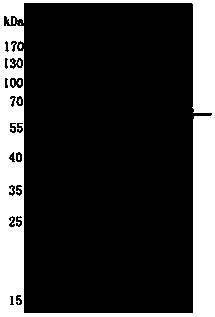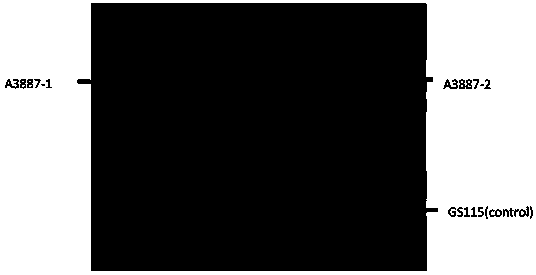Hyaluronidase encoding gene and fermentation production and purification method thereof
A hyaluronidase and gene technology, applied in the field of bioengineering, can solve the problems of extraction and separation steps limiting the wide application of leech hyaluronidase
- Summary
- Abstract
- Description
- Claims
- Application Information
AI Technical Summary
Problems solved by technology
Method used
Image
Examples
Embodiment 1
[0025] Embodiment 1: Wild leech RNA is extracted
[0026] Take a living leech, cut about 100 mg of head tissue, and freeze it quickly with liquid nitrogen. The tissue was fully ground by liquid nitrogen grinding method, and the total RNA extraction kit from tissue / cell (Hangzhou Baosai Biotechnology Co., Ltd.) was used for extraction. Add 1ml of lysate, vortex and mix quickly to fully lyse the cells and inactivate RNase, and incubate at room temperature for 2 minutes. Add 0.2ml of chloroform, shake and mix vigorously to make the sample turn milky white, and let it stand for 2-3min. Centrifuge at 12,000 rpm at 4°C for 10 min, divide the sample into three layers, and transfer the RNA-containing aqueous phase in the upper layer to a new tube. Add 1 / 2 volume of absolute ethanol, invert and mix well, transfer all to the adsorption column, and centrifuge at 12,000 rpm at 4°C for 1 min. Discard the filtrate, add 500 μl protein-removing solution, centrifuge at 12,000 rpm at 4°C for...
Embodiment 2
[0027] Example 2: Preparation of cDNA by reverse transcription
[0028]The reverse transcription cDNA was prepared using M-MLV First Strand RT kit (Hangzhou Baosai Biotechnology Co., Ltd.). Using the extracted leech RNA as a template, configure the reaction mixture according to the following (20 μl) system: 5×First-Strand buffer, 4 μl; Oligo(dT) 18 Primer (50 μM), 1 μl; 10 mM dNTP, 1 μl; RNase Inhibitor (40 U / μl), 1 μl; M-MLV (200 U / μl), 1 μl; RNA, 12 μl. The reaction system was placed in a PCR instrument at 50°C for 1 h. The reaction was terminated by heating at 70°C for 10 min. Store on ice for subsequent experiments or store at -80°C.
Embodiment 3
[0029] Embodiment 3: Acquisition of leech hyaluronidase gene
[0030] By searching and analyzing the leech EST in the Expressed sequence tags (EST) of the NCBI database, two incomplete mRNA genes (GenBank: JZ186329.1 and GenBank: FP652258.1) were found to be similar to the heparanase gene (homology lower than 40%), and by further comparison with other hyaluronidases, it was preliminarily confirmed that these two incomplete mRNA sequences were leech hyaluronidase sequences. According to these two sequences, two degenerate primers (EST1: CTGGTGMYCACRTAACYGCTTTTAC; EST2: TCAACATACCTTGAYGCYWCWTA) were designed near the 5-end. The degenerate primers are respectively used as upstream primers, and the downstream primers are Oligo(dT) 18 , using the cDNA prepared in Example 2 as a template, PCR amplifies the target fragment. Amplified by PCR, obtained with primers EST1 and Oligo(dT) 18 Amplified target fragment of about 900bp. The target fragment was recovered, connected to the PM...
PUM
 Login to View More
Login to View More Abstract
Description
Claims
Application Information
 Login to View More
Login to View More - R&D
- Intellectual Property
- Life Sciences
- Materials
- Tech Scout
- Unparalleled Data Quality
- Higher Quality Content
- 60% Fewer Hallucinations
Browse by: Latest US Patents, China's latest patents, Technical Efficacy Thesaurus, Application Domain, Technology Topic, Popular Technical Reports.
© 2025 PatSnap. All rights reserved.Legal|Privacy policy|Modern Slavery Act Transparency Statement|Sitemap|About US| Contact US: help@patsnap.com



